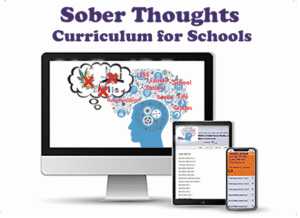Speaker for Middle Schools on Drugs and Alcohol
Empowering Middle School Students to Make Smart, Confident Choices
Middle School can be a challenging time with pressures and influences. Having a school speaker can give your students the tools to understand and overcome these challenges and pressures. This is most effective when a speaker keeps your middle schoolers engaged, laughing, and learning. As a speaker for middle schools on drug and alcohol awareness, that’s what Robert Hackenson Jr.’s edutaining presentations will do.
Why Middle School Is the Turning Point
Middle school is when students start asking: “Who am I?” and “Where do I fit in?”
It’s also when they begin facing early exposure to substances, vaping, and online influence. They’re forming habits and beliefs that shape their teenage years—and prevention at this stage is critical.
Robert Hackenson Jr. bridges that gap with an approach that connects directly to their developing sense of identity, belonging, and independence. Instead of thinking just “live your life,” Robert teaches students to think, “Build Your Life.” He focuses on how our decisions are the building blocks, but there are situations and challenges students will face that can influence these decisions. Then he explores the different tools necessary make smart decisions during these challenging times.
As seen/heard on:

Meet Robert Hackenson Jr.: The “Edutainer” Students Actually Listen to
For more than 20 years, Robert has helped schools nationwide inspire students to think before they act. His reputation as a top middle school motivational and substance awareness speaker comes from his unique blend of education, psychology, and entertainment.
Using magic, illusions, and humor, Robert explains complex ideas about peer pressure, emotions, and consequences in a way 11–14-year-olds can understand and remember. Students see how their decisions ripple out—and how to build confidence to make the right decisions when faced with difficult situations.
What Students Will Learn
Robert’s middle school presentation focuses on self-awareness, confidence, and healthy coping. It’s the foundation for preventing risky behavior before it starts.
Core Lessons Include:
- Setting goals and aspirations
- Understanding peer pressure and how to make independent choices.
- Seeing through social media myths and influencer pressures.
- Recognizing emotions that can lead to poor decisions (stress, loneliness, frustration) and finding better solutions.
- Building confidence to walk away from risky situations.
- Understanding the misperceptions of substance that can be seen as “safe” like vaping nicotine, THC, OTC and Prescription pills, etc.
- Knowing how to make smart decisions when things feel tough.
Each message ties directly into SEL objectives and school wellness priorities.
Why It Works...
Middle school students are easily distracted and crave authenticity. Robert uses high-energy and interactive demonstrations and storytelling to grab attention—and then keeps it through empathy and relevance.
Program Features:
- 🎩 Magic & Visual Illusions – Show how perceptions and peer pressure can trick us.
- 😂 Age-Appropriate Humor – Builds rapport and breaks down resistance.
- 🧠 Research-Based Messages – Simplifies the neuroscience of choices and consequences.
- 💬 Real-Life Scenarios – Students explore how to react to stress, embarrassment, or rejection.
This combination ensures the message sticks long after the assembly ends.
Designed for Educational Alignment
Flexible Formats for Every Schedule
Outcomes Schools Notice
This presentation supports Social Emotional Learning (SEL) and health education standards by addressing:
- Goal setting
- Responsible decision-making
- Self-awareness and self-management
- Social awareness and relationship skills
- Healthy coping and communication
It integrates seamlessly with wellness weeks, Red Ribbon Week, prevention education, or stand-alone assemblies.
Robert offers in-person, hybrid, and virtual delivery options. Schools can schedule:
- One 50–60 minute assembly, or
- Multiple assemblies for different grade levels, or
- A full-day package with both student and evening parent programs.
Each option includes customizable content and pacing to fit your bell schedule, auditorium/gym setup, and audience size.
- Students demonstrate improved self-control and empathy.
- Teachers report higher engagement in follow-up SEL lessons.
- Parents note more open discussion about peer pressure and choices.
- Fewer incidents of vaping or experimentation following presentations.
Frequently Asked Questions (FAQs)
Q1: What grades is this presentation designed for?
Primarily grades 6–8, though it can be adapted for advanced grade 5 or freshman transition programs. We do have other presentations tailored for older and younger grades as well.
Q2: How long is the program?
About 50–60 minutes, depending on your bell schedule and event structure.
Q3: Does it meet SEL and prevention goals?
Yes. It reinforces self-awareness, decision-making, and responsible behavior consistent with state and CASEL SEL standards.
Q4: Can we combine middle school and high school presentations?
Yes. Many districts book a full day with morning middle school, afternoon high school, and evening parent sessions under one flat-day rate.
Includes 1 Year Access to Curriculum for FREE!
 The learning doesn’t have to stop after the assembly. Along with each substance awareness school assembly presentation, your school will get access to the Sober Thoughts curriculum for 1 calendar year for FREE through our online portal. This curriculum includes videos, class discussion questions, and class activities and/or assignments that goes along with the substance awareness presentation. This keeps the learning going far beyond the presentation and reinforces the important lessons.
The learning doesn’t have to stop after the assembly. Along with each substance awareness school assembly presentation, your school will get access to the Sober Thoughts curriculum for 1 calendar year for FREE through our online portal. This curriculum includes videos, class discussion questions, and class activities and/or assignments that goes along with the substance awareness presentation. This keeps the learning going far beyond the presentation and reinforces the important lessons.
Flat Day Rate Pricing Option
 The flat day rate offers up to 4 presentations within 24 hours for 1 flat rate. These presentations can be on different topics, for different grades, at different schools, and can include a parent/community night. This allows schools to work together and maximize budgets and resources.
The flat day rate offers up to 4 presentations within 24 hours for 1 flat rate. These presentations can be on different topics, for different grades, at different schools, and can include a parent/community night. This allows schools to work together and maximize budgets and resources.

